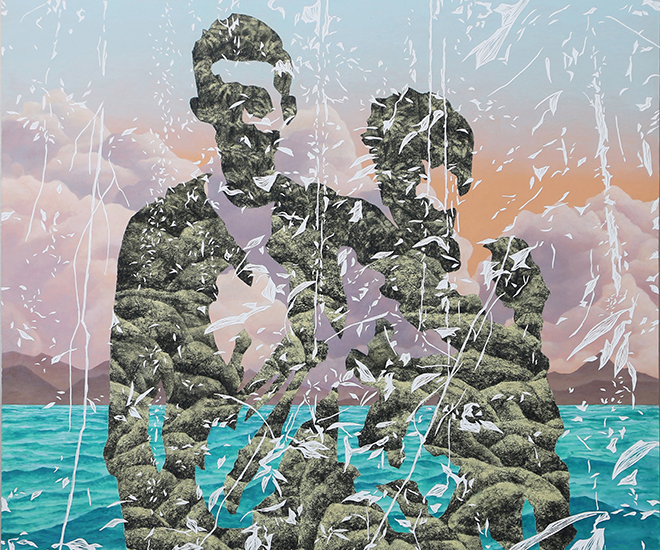Bridges and Ferrymen: a Book Review by Ian Tee
An exposition on ‘Dreams from the Golden Island’

“Dreams from the Golden Island” book cover, 2018, based on painting by Heri Dono and design by Iman Kurnia. Image courtesy the artists.
‘Dreams from the Golden Island’ is a publication by Jogjakarta-based writer Elisabeth Inandiak and Padmasana Foundation, a non-profit cultural advocacy organisation from Muara Jambi, a village on the island of Sumatra, Indonesia. The book chronicles the story of this place, starting from the 7th century where it was at the crossroads of the Buddhist Sea Route between India and China. In its heart was a vast university complex, the largest in Southeast Asia which disappeared from history after the 13th century. Today, Muara Jambi is inhabited by a village of Muslims, who are the custodians of this archeological site and the dreamers of this story.

Group photo with members of Padmasana Foundation, Pan Cheng Lui, Elisabeth Inandiak and Tan Swie Hian, taken at Telok Kurau Studios on 27 January 2018. Image courtesy Padmasana Foundation.
This book does not simply narrate a brief account of Sumatra’s pre-Islamic history but also provides insights about local customs practiced today. It is richly illustrated with drawings by Pebrianto Putra, a young painter from the village, and features contributions by established contemporary artists such as Heri Dono, whose painting is on the cover. The book also opens with a calligraphy by Singaporean artist Tan Swie Hian, of ‘The Golden Light Sutra’. A text translated from Sanskrit into Chinese in the year 703 by I-Tsing, a Buddhist monk who made important sea journeys to Nalanda university in India in his quest for knowledge. A predecessor of I-Tsing who might be more familiar is Xuanzang whose pilgrimage across the Silk Road inspired the Chinese epic ‘Journey to the West’.
Indeed, these ancient travelers are not the only figures seeking and propagating knowledge. ‘Dreams from the Golden Island’ is written an easily accessible manner, suitable even as a children’s book and translated into four languages (English, French, Bahasa Indonesia and Mandarin). Singaporean author and poet Pan Cheng Lui contributed the book’s Mandarin translation and cited the importance of its content for Chinese Buddhists as an impetus for coming on board the project.

“Atisha’s meeting with Serlingpa”, 2017, digital image made with Pebrianto Putra’s replica of a mural in Drepung monastery and Tibetan calligraphy by Ven. Tenzin Dakpa (Tashila). Image courtesy the artists.
I am interested to look at this book through the lens of its advocative role and how art provided a space to bridge people across different regions. This is best manifested in a series of coloured images recounting the life of Atisha, an Indian sage who studied in Sumatra for 12 years and later brought the teachings to Tibet. What seem to be didactic illustrations are in fact Putra’s replica of murals found in Drepung Monastery (Tibet’s largest monastery) which are overlaid with calligraphy by Ven. Tenzin Dakpa. Ven. Tenzin Dakpa visited Muara Jambi in 2012 and asked why he had to make the long journey from Tibet, he replied, “Since my childhood, I have studied the teachings and life of Atisha. I dreamed of this golden island as a fantasy island. And here I am, it was not a dream.”
As such, the gestures behind these images constitute a story told by the multiple hands involved. That indeed, Muara Jambi is a point of connection between Sumatra and Tibet because of their shared history and the movement of information. This is captured in the way these images are produced, which presented an otherwise impossible meeting of people across space and time. It is poetic how Atisha’s spirit found resonance in the arts, that broke the boundaries of division commonly instated by differences in nationality, ethnicity and religion.

Candi Teluk, one of the unexcavated temple compounds threatened by encroaching industry. Image courtesy Padmasana Foundation.
Here I quote Iman Kurnia, a member of Padmasana Foundation responsible for the book design: “Art that does not know limits, it is borderless because we unite as citizens of the world. Merging doesn’t mean we have to be the same, as difference generates strength, like a differential on the gearbox. The higher the differential, the more torque.”
While I am no expert in mechanics and engineering, but what I related from Kurnia’s analogy is how it dealt with moving at different speeds, or perhaps registers. As the book shifted from historical context into modern troubles, this is where Padmasana’s advocative message comes through. Beyond historical significance, what they want to underscore too, is the environmental threats Muara Jambi faces against the encroachment of industry. In spite of its official status as a national heritage site, sand mining remains on the Batanghari river. It is an activity that has not only resulted in ecological devastation but also endanger artefacts on the river bed, which are often gold treasures which could provide archaeological clues as to why this massive ancient university sunk into oblivion. This lamentation is voiced in Mukhtar Hadi’s poem ‘Disaster on the Land of Melayu’, which was translated into a powerful performance presented in January 2018 at LASALLE’s Institute of Contemporary Arts Singapore.

Padmasana Foundation, “The disasters on the land of history”, 2018, performance on the exhibition opening of “To leave home is already half the journey” at LASALLE’s Institute of Contemporary Arts Singapore, 5 minutes (approx.). Image documentation courtesy Padmasana Foundation.
The waters of the Batanghari can no longer soothe the thirst
Its currents that once ferried glorious tales
Today bring news of disaster to the Golden Island
The Prajnaparamita is petrified with shame
She would like to escape human rapacity
Reduced to silence, she remains petrified
Mukhtar Hadi (Borju), 2017, Excerpt from ‘Disaster on the Land of Melayu’
I end this exposition with a quaint watercolour drawing by Putra of Bukit Perak or Silver Hill, where a local legend tells of how the hill would lend silver plates to the villagers for their wedding banquets. Unfortunately, it stopped producing magic plates after the 1960s when some dishonest people did not return the silverware. If this folklore is a cautionary tale about the relationship between land and human greed, ‘Dreams from the Golden Island’ presents but a small fragment of what would be lost should the small voices from Muara Jambi remain unheard.
For more information contact Elisabeth Inandiak at [email protected].









